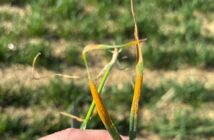Certis announce their new, advanced ferric phosphate slug pellet, Sluxx HP, is now available to growers.
With slug numbers reported to be rising under the recent heavy wet conditions, the introduction comes at just the right time for growers to reap the benefits of the new formulation, says Inez Cornell, Certis’ arable product manager.
Sluxx HP (high performance) adds additional rainfastness, along with greater resilience to mould growth, to Certis’ already proven, unique and patented formulation of ferric phosphate.
“The most noticeable difference to Sluxx HP is the colour of the pellets, which are a darker, more vibrant blue colour than the original formulation. The pellet is now more visible on the soil surface so it will be easier for growers to monitor the number of baiting points left in the days following application,” explains Inez.
“Because slugs retreat out of sight to die when they have eaten a ferric phosphate pellet, the number of pellets remaining on the soil surface is a good indicator of slug population and the level of slug activity.
“In our extensive testing, Sluxx HP has even better rainfastness and pellet durability than the original formulation, but with the same application rates, number of baiting points, and spreading characteristics as the previous formulation of Sluxx. Because ferric phosphate is insoluble, and Sluxx HP offers a resilient pellet, any pellet remaining on the soil surface remains lethal to slugs,” she adds.
“This is a particularly useful property under wet conditions when slugs continue to breed and graze but pellet application may not be practicable.
“Another key feature of Sluxx HP is a much improved resilience against mould growth, which means under warmer, humid conditions, the pellet is not compromised,” says Inez.
“The fact that Sluxx HP has improved durability with no adverse effect on attractiveness and palatability to slugs is an important benefit of the new formulation,” says Inez, pointing out that one of the key advantages of ferric phosphate is its proven ability to kill young juvenile slugs because they find it so palatable.
According to AHDB work, juvenile slugs are capable of causing more damage than their adult counterparts on a weight for weight basis. “Although slugs can breed all year round, there is usually a peak in breeding activity during May and September, if conditions are right. With a wet May behind us and soil conditions looking damp going into September, juvenile slugs are likely to play a part this autumn,” says Inez.



